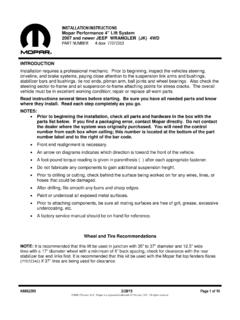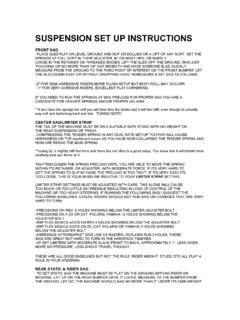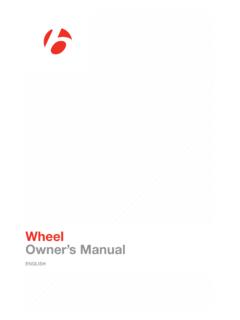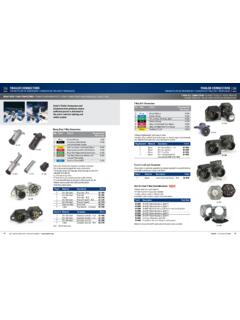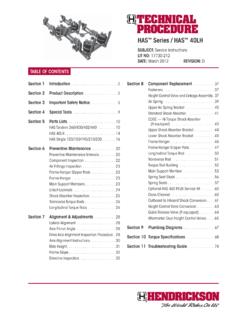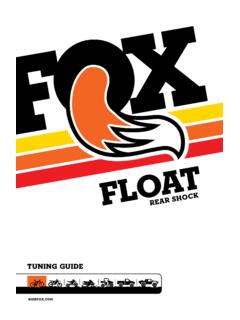Transcription of Thorough examination and testing of lifts - HSE
1 1 of 5 pagesHealth and Safety ExecutiveThorough examinationand testing of liftsSimple guidance for lift ownersHealth and Safety ExecutiveThorough examination and testing of liftsSimple guidance for lift owners This is a web-friendly version of leaflet INDG339(rev1), revised 01/08 IntroductionThe Lifting Operations and Lifting Equipment Regulations 1998 (LOLER) introduced new requirements for the safe provision and use of lifting equipment. Regulation 9 of LOLER requires that all lifts provided for use in work activities are thoroughly examined by a competent person at regular intervals. This applies to lifts and hoists used to lift people or you are a lift owner or someone responsible for the safe operation of a lift used at work, such as a facilities manager or supervisor, you are a dutyholder under LOLER.
2 This means that you have a legal responsibility to ensure that the lift is thoroughly examined and that it is safe to use. (If you are the owner of a lift used primarily by members of the public, you may also find this guidance helps you to comply with more general health and safety legal duties under the Health and Safety at Work etc Act 1974.)This leaflet explains what you need to do to comply with the is a Thorough examination ?A Thorough examination is a systematic and detailed examination of the lift and all its associated equipment by a competent person. Its aim is to detect any defects which are, or might become, dangerous, and for the competent person to report them to the dutyholder and, if appropriate, the enforcing authority (the Health and Safety Executive or local authority) so that appropriate remedial action can be determine the extent of the Thorough examination , the competent person will assess the risks, considering factors such as where the lift will be used, frequency of use, age and condition, the weight of loads to be lifted, Thorough examination may include some testing , if the competent person considers it to be necessary.
3 The competent person will normally determine what tests are required, taking account of the relevant guidance and standards (see Further information), and dutyholders are recommended to insist on this examination may also be supplemented by inspection. Inspections should be carried out at suitable intervals between Thorough examinations and may be done in-house by a competent, trained employee. Inspections would normally include visual and functional checks, eg that the alarm interlocks operate correctly and lift doors cannot be opened from the landing of 5 pagesHealth and Safety ExecutiveThorough examination and testing of liftsThorough examination should not be confused with preventive maintenance, although they have some elements in common.
4 Preventive maintenance usually involves replacing worn or damaged parts, topping up fluid levels and making routine adjustments to ensure risks are avoided. Thorough examination may act as a check that maintenance is being carried out properly, but is not intended to replace examination should include the following:landing and car doors and their interlocks; worm and other gearing; main drive system components; governors; safety gear; suspension ropes; suspension chains; overload detection devices; electrical devices (including earthing, earth bonding, safety devices, selection of fuses, etc);braking systems (including buffers and overspeed devices); and hydraulics.
5 This list is not exhaustive. More detailed guidance can be found in the Safety Assessment Federation s (SAFed) Lift guidelines (see Further information).Role of the dutyholderAs the dutyholder you are legally responsible for ensuring that the lift is safe to use and that it is thoroughly examined. These responsibilities include:maintaining the lift so that it is safe to use; selecting and instructing the competent person; ensuring that the lift is examined at statutory intervals (every 6 or 12 months) or in accordance with an examination scheme drawn up by a competent person;keeping the competent person informed of any changes in the lift operating conditions which may affect the risk assessment;making relevant documentation available to the competent person, eg manufacturer s instructions and maintenance records;acting promptly to remedy any defects; ensuring that all documentation complies with the Regulations.
6 And record keeping. Selecting a competent personA competent person is someone who has sufficient technical and practical knowledge of the lift to be able to detect any defects and assess how significant they are. It is also important that the competent person is sufficiently independent and impartial to allow them to make an objective assessment of the lift. For this reason, it is not advisable for the same person who performs routine maintenance to carry out the Thorough examination , as they are then responsible for assessing their own can use someone from an external company or someone from within Your own organisation to act as the competent person as long as they meet the above criteria.
7 However, few owners or lift operators have the necessary competence in-house. If you intend to use an external person, 3 of 5 pagesHealth and Safety ExecutiveThorough examination and testing of liftsyou should ensure that they understand what is meant by a Thorough examination and what the law requires. Accreditation by the United Kingdom Accreditation Service to the relevant standard (BS EN ISO/IEC 17020:2004) is an indication of the competence of an inspection body. Most insurance companies can recommend accredited inspecting Thorough examinationThe law requires that all lifts when in use should be thoroughly examined:after substantial and significant changes have been made; at least every six months if the lift is used at any time to carry people, every 12 months if it only carries loads, or in accordance with an examination scheme.
8 Andfollowing exceptional circumstances such as damage to, or failure of, the lift, long periods out of use or a major change in operating conditions which is likely to affect the integrity of the : When first installed, new lifts do not require any initial Thorough examination as long as they have been manufactured and installed in accordance with the lifts Regulations 1997 and have a current declaration of conformity, ie made not more than 12 months before. A new lift is one where:no lift previously existed; an existing lift has been completely replaced; or only the existing guide rails and their fixings or the fixings alone have been retained.
9 **Guide to application of the lifts Directive 95/16/EC; details available from the Europa website at: schemesAs an alternative to Thorough examinations at statutory intervals, the competent person may draw up an examination scheme . The scheme may specify periods which are different from the statutory intervals, but this must be based on a rigorous assessment of the risks. An examination scheme may be particularly appropriate if you have a lift which is used infrequently for light following notification of defectsThe competent person is legally required to notify you as soon as possible, following a Thorough examination , of any defects which are, or could soon become, dangerous.
10 If you are notified of a serious and significant defect you should immediately take the lift out of service until the fault has been addressed. If you do not take the lift out of operation you will be in breach of the competent person may also notify you of defects which need to be made good within a certain timescale. In this case, you should take steps to have the defective equipment repaired or replaced within the specified time, and not use the lift after that time unless the defect has been satisfactorily of 5 pagesHealth and Safety ExecutiveThorough examination and testing of liftsDocumentationThe competent person is legally required to send you a written and signed report of the Thorough examination as soon as practicable.










